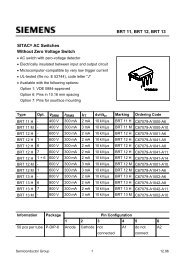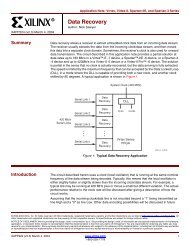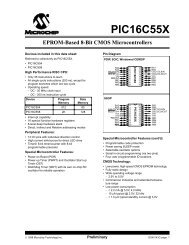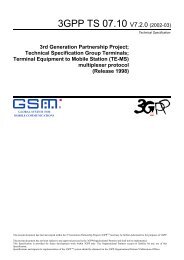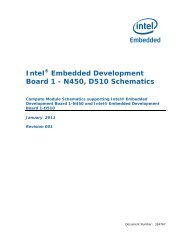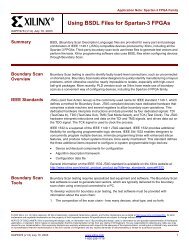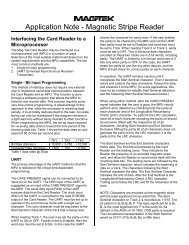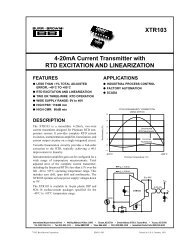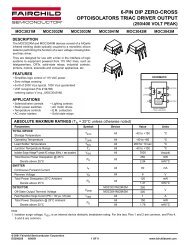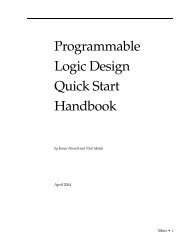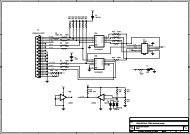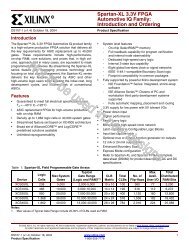Xilinx Using IBIS Models for Spartan-3 FPGAs application note ...
Xilinx Using IBIS Models for Spartan-3 FPGAs application note ...
Xilinx Using IBIS Models for Spartan-3 FPGAs application note ...
Create successful ePaper yourself
Turn your PDF publications into a flip-book with our unique Google optimized e-Paper software.
R<br />
<strong>IBIS</strong> Background<br />
<strong>Xilinx</strong> SPICE models are only available upon completion of a Non-Disclosure Agreement (NDA)<br />
and <strong>application</strong> evaluation process; there<strong>for</strong>e it is recommended that <strong>IBIS</strong> models be used<br />
wherever possible. See more in<strong>for</strong>mation on SPICE at:<br />
http://www.xilinx.com/xlnx/xil_prodcat_product.jspipoid=66136&sSecondaryNavPick=Design<br />
+Tools&sGlobalNavPick=PRODUCTS<br />
<strong>IBIS</strong><br />
Background<br />
<strong>Xilinx</strong> Support<br />
of <strong>IBIS</strong><br />
<strong>IBIS</strong>, originally developed by Intel, is an alternative to SPICE simulation. The <strong>IBIS</strong> specification<br />
now is maintained by the EIA/<strong>IBIS</strong> Open Forum, which has members from a large number of IC<br />
and EDA vendors. <strong>IBIS</strong> is the ANSI/EIA-656 and IEC 62014-1 standard. For more in<strong>for</strong>mation<br />
about the <strong>IBIS</strong> specification, see http://www.eigroup.org/ibis/ibis.htm.<br />
The core of the <strong>IBIS</strong> model consists of a table of current versus voltage and timing in<strong>for</strong>mation.<br />
This is very attractive to the IC vendor as the I/O internal circuit is treated as a black box. This<br />
way, transistor-level in<strong>for</strong>mation about the circuit and process details is not revealed.<br />
<strong>IBIS</strong> models can be used to model best-case and worst-case conditions (best-case = strong<br />
transistors, low temperature, high voltage; worst-case = weak transistors, high temperature,<br />
low voltage). The “fast/strong” model represents best-case conditions, while the "slow/weak"<br />
model represents worst-case conditions. The "typical" model represents typical behavior.<br />
<strong>IBIS</strong> cannot be used <strong>for</strong> internal timing in<strong>for</strong>mation (propagation delays and skew); the timing<br />
models instead provide that in<strong>for</strong>mation. <strong>IBIS</strong> also does not model power and ground structures<br />
or pin-to-pin coupling. The implications are that ground bounce, power supply droop, and<br />
simultaneous switching output (SSO) noise cannot be simulated with <strong>IBIS</strong> models. Instead,<br />
<strong>Xilinx</strong> provides device/package-dependent SSO guidelines once extensive lab measurements<br />
are completed. <strong>IBIS</strong> models also do not provide detailed package parasitic in<strong>for</strong>mation.<br />
Package parasitics usually are provided in the <strong>for</strong>m of lumped RLC data, which loses its<br />
accuracy at higher speeds. To model the package parasitics accurately, include a transmission<br />
line with a delay of 25 ps to 100 ps and an impedance of 65Ω.<br />
<strong>Using</strong> <strong>IBIS</strong> models has a great advantage to the user in that simulation speed is significantly<br />
increased over SPICE, while accuracy is only slightly decreased. Non-convergence, which can<br />
be a problem with SPICE models and simulators, is eliminated in <strong>IBIS</strong> simulation. Virtually all<br />
EDA vendors presently support <strong>IBIS</strong> models, and ease of use of these <strong>IBIS</strong> simulators is<br />
generally very good. <strong>IBIS</strong> models <strong>for</strong> most devices are freely available over the Internet making<br />
it easy to simulate several different manufacturers’ devices on the same board. Several different<br />
<strong>IBIS</strong> simulators are available today, and each simulator provides different results. An overshoot<br />
or undershoot of ±10% of the measured result is tolerable. Differences between the model and<br />
measurements occur because not all parameters are modeled. Simulators <strong>for</strong> <strong>IBIS</strong> models are<br />
provided by Cadence, Avanti Corporation, Hyperlynx, Mentor, Microsim, Intusoft, Veribest, and<br />
Viewlogic. See the links to third-party <strong>IBIS</strong> tools at:<br />
http://www.xilinx.com/xlnx/xil_prodcat_product.jsptitle=si_simulation.<br />
<strong>Xilinx</strong> provides <strong>IBIS</strong> models <strong>for</strong> all current products; they are downloaded easily from our<br />
website at http://www.xilinx.com/support/sw_ibis.htm. The models also are made available in<br />
the development system. The Preliminary models are based initially on simulation and then<br />
verified against the silicon.<br />
An <strong>IBIS</strong> file contains two sections, the header and the model data <strong>for</strong> each component. One<br />
<strong>IBIS</strong> file can describe several devices. The following is the content list in a typical <strong>IBIS</strong> file:<br />
• <strong>IBIS</strong> Version<br />
• File Name<br />
• File Revision<br />
• Component<br />
• Package R/L/C<br />
2 www.xilinx.com XAPP475 (v1.0) June 21, 2003<br />
1-800-255-7778



